Gorka Azkune
Adding simple structure at inference improves Vision-Language Compositionality
Jun 11, 2025Abstract:Dual encoder Vision-Language Models (VLM) such as CLIP are widely used for image-text retrieval tasks. However, those models struggle with compositionality, showing a bag-of-words-like behavior that limits their retrieval performance. Many different training approaches have been proposed to improve the vision-language compositionality capabilities of those models. In comparison, inference-time techniques have received little attention. In this paper, we propose to add simple structure at inference, where, given an image and a caption: i) we divide the image into different smaller crops, ii) we extract text segments, capturing objects, attributes and relations, iii) using a VLM, we find the image crops that better align with text segments obtaining matches, and iv) we compute the final image-text similarity aggregating the individual similarities of the matches. Based on various popular dual encoder VLMs, we evaluate our approach in controlled and natural datasets for VL compositionality. We find that our approach consistently improves the performance of evaluated VLMs without any training, which shows the potential of inference-time techniques. The results are especially good for attribute-object binding as shown in the controlled dataset. As a result of an extensive analysis: i) we show that processing image crops is actually essential for the observed gains in performance, and ii) we identify specific areas to further improve inference-time approaches.
Vision-Language Models Struggle to Align Entities across Modalities
Mar 05, 2025Abstract:Cross-modal entity linking refers to the ability to align entities and their attributes across different modalities. While cross-modal entity linking is a fundamental skill needed for real-world applications such as multimodal code generation, fake news detection, or scene understanding, it has not been thoroughly studied in the literature. In this paper, we introduce a new task and benchmark to address this gap. Our benchmark, MATE, consists of 5.5k evaluation instances featuring visual scenes aligned with their textual representations. To evaluate cross-modal entity linking performance, we design a question-answering task that involves retrieving one attribute of an object in one modality based on a unique attribute of that object in another modality. We evaluate state-of-the-art Vision-Language Models (VLMs) and humans on this task, and find that VLMs struggle significantly compared to humans, particularly as the number of objects in the scene increases. Our analysis also shows that, while chain-of-thought prompting can improve VLM performance, models remain far from achieving human-level proficiency. These findings highlight the need for further research in cross-modal entity linking and show that MATE is a strong benchmark to support that progress.
Improving the Efficiency of Visually Augmented Language Models
Sep 17, 2024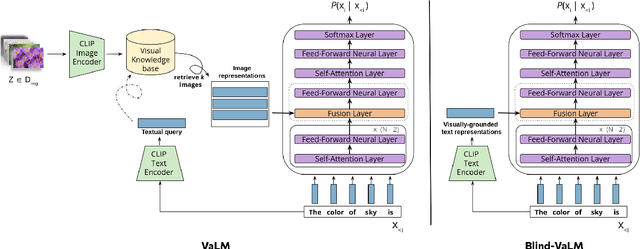

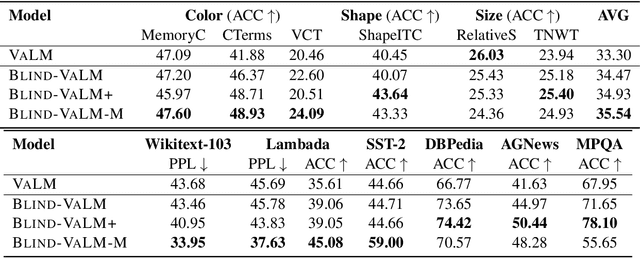
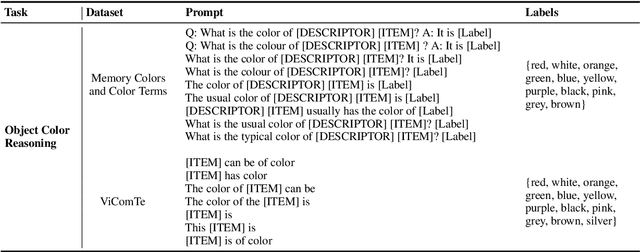
Abstract:Despite the impressive performance of autoregressive Language Models (LM) it has been shown that due to reporting bias, LMs lack visual knowledge, i.e. they do not know much about the visual world and its properties. To augment LMs with visual knowledge, existing solutions often rely on explicit images, requiring time-consuming retrieval or image generation systems. This paper shows that explicit images are not necessary to visually augment an LM. Instead, we use visually-grounded text representations obtained from the well-known CLIP multimodal system. For a fair comparison, we modify VALM, a visually-augmented LM which uses image retrieval and representation, to work directly with visually-grounded text representations. We name this new model BLIND-VALM. We show that BLIND-VALM performs on par with VALM for Visual Language Understanding (VLU), Natural Language Understanding (NLU) and Language Modeling tasks, despite being significantly more efficient and simpler. We also show that scaling up our model within the compute budget of VALM, either increasing the model or pre-training corpus size, we outperform VALM for all the evaluation tasks.
BiVLC: Extending Vision-Language Compositionality Evaluation with Text-to-Image Retrieval
Jun 14, 2024Abstract:Existing Vision-Language Compositionality (VLC) benchmarks like SugarCrepe are formulated as image-to-text retrieval problems, where, given an image, the models need to select between the correct textual description and a synthetic hard negative text. In this work we present the Bidirectional Vision-Language Compositionality (BiVLC) dataset. The novelty of BiVLC is to add a synthetic hard negative image generated from the synthetic text, resulting in two image-to-text retrieval examples (one for each image) and, more importantly, two text-to-image retrieval examples (one for each text). Human annotators filter out ill-formed examples ensuring the validity of the benchmark. The experiments on BiVLC uncover a weakness of current multimodal models, as they perform poorly in the text-to-image direction. In fact, when considering both retrieval directions, the conclusions obtained in previous works change significantly. In addition to the benchmark, we show that a contrastive model trained using synthetic images and texts improves the state of the art in SugarCrepe and in BiVLC for both retrieval directions. The gap to human performance in BiVLC confirms that Vision-Language Compositionality is still a challenging problem. BiVLC and code are available at https://imirandam.github.io/BiVLC_project_page.
BertaQA: How Much Do Language Models Know About Local Culture?
Jun 11, 2024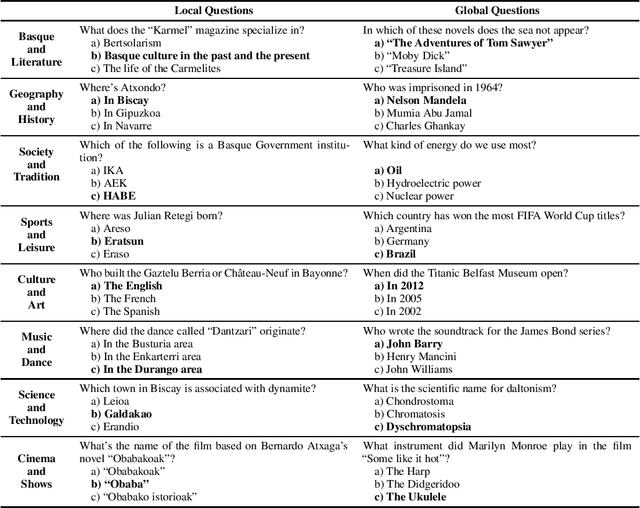
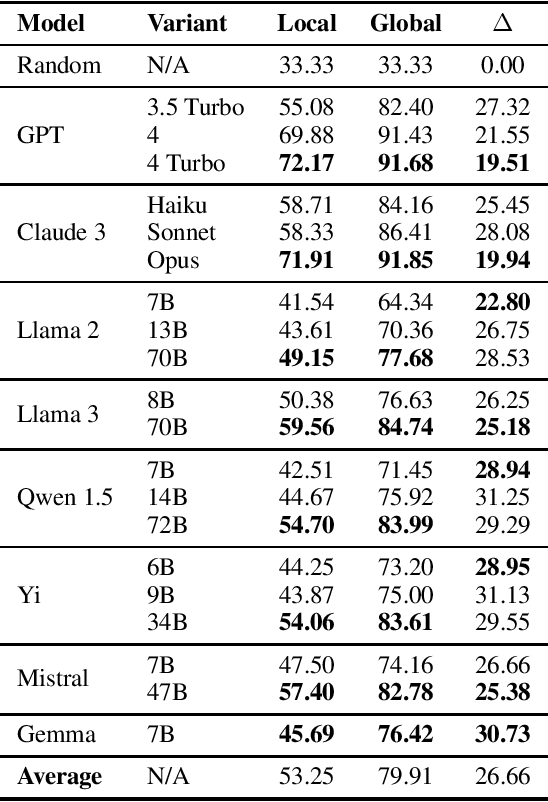
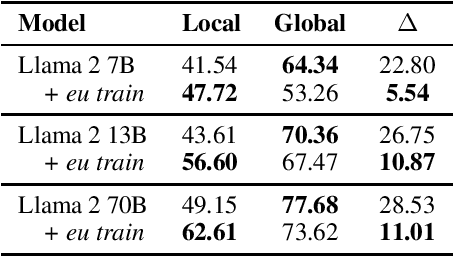
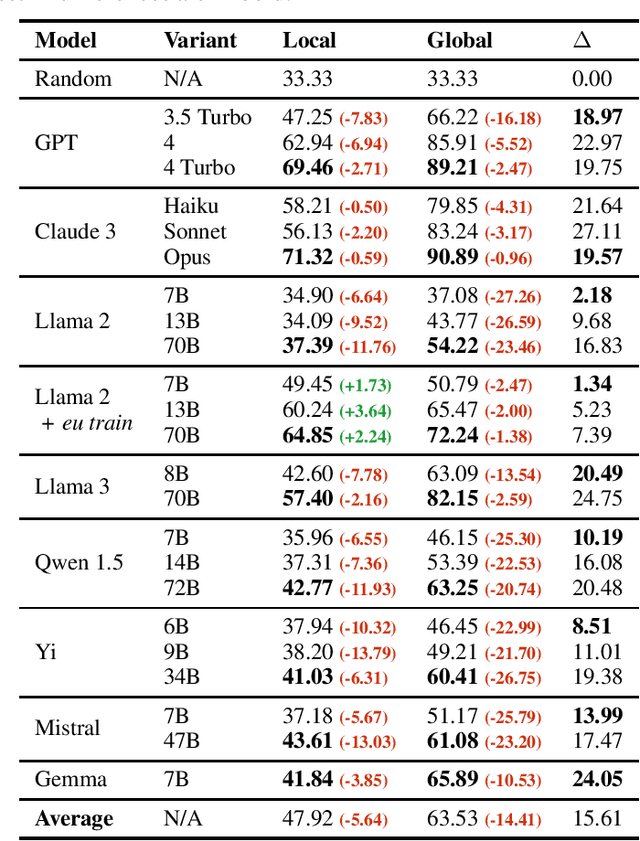
Abstract:Large Language Models (LLMs) exhibit extensive knowledge about the world, but most evaluations have been limited to global or anglocentric subjects. This raises the question of how well these models perform on topics relevant to other cultures, whose presence on the web is not that prominent. To address this gap, we introduce BertaQA, a multiple-choice trivia dataset that is parallel in English and Basque. The dataset consists of a local subset with questions pertinent to the Basque culture, and a global subset with questions of broader interest. We find that state-of-the-art LLMs struggle with local cultural knowledge, even as they excel on global topics. However, we show that continued pre-training in Basque significantly improves the models' performance on Basque culture, even when queried in English. To our knowledge, this is the first solid evidence of knowledge transfer from a low-resource to a high-resource language. Our analysis sheds light on the complex interplay between language and knowledge, and reveals that some prior findings do not fully hold when reassessed on local topics. Our dataset and evaluation code are available under open licenses at https://github.com/juletx/BertaQA.
When to Retrieve: Teaching LLMs to Utilize Information Retrieval Effectively
Apr 30, 2024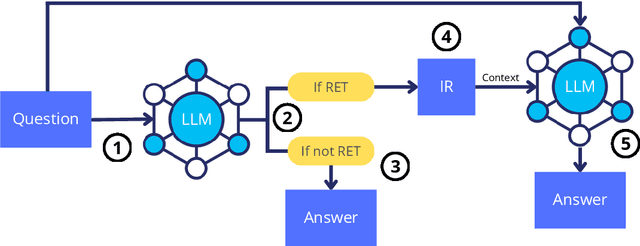
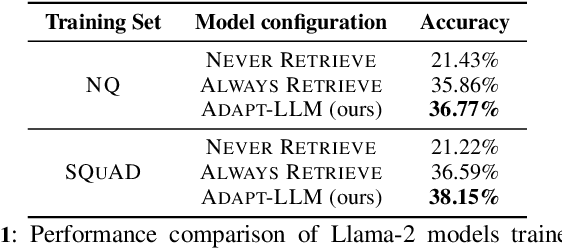


Abstract:In this paper, we demonstrate how Large Language Models (LLMs) can effectively learn to use an off-the-shelf information retrieval (IR) system specifically when additional context is required to answer a given question. Given the performance of IR systems, the optimal strategy for question answering does not always entail external information retrieval; rather, it often involves leveraging the parametric memory of the LLM itself. Prior research has identified this phenomenon in the PopQA dataset, wherein the most popular questions are effectively addressed using the LLM's parametric memory, while less popular ones require IR system usage. Following this, we propose a tailored training approach for LLMs, leveraging existing open-domain question answering datasets. Here, LLMs are trained to generate a special token, <RET>, when they do not know the answer to a question. Our evaluation of the Adaptive Retrieval LLM (Adapt-LLM) on the PopQA dataset showcases improvements over the same LLM under three configurations: (i) retrieving information for all the questions, (ii) using always the parametric memory of the LLM, and (iii) using a popularity threshold to decide when to use a retriever. Through our analysis, we demonstrate that Adapt-LLM is able to generate the <RET> token when it determines that it does not know how to answer a question, indicating the need for IR, while it achieves notably high accuracy levels when it chooses to rely only on its parametric memory.
Grounding Spatial Relations in Text-Only Language Models
Mar 20, 2024



Abstract:This paper shows that text-only Language Models (LM) can learn to ground spatial relations like "left of" or "below" if they are provided with explicit location information of objects and they are properly trained to leverage those locations. We perform experiments on a verbalized version of the Visual Spatial Reasoning (VSR) dataset, where images are coupled with textual statements which contain real or fake spatial relations between two objects of the image. We verbalize the images using an off-the-shelf object detector, adding location tokens to every object label to represent their bounding boxes in textual form. Given the small size of VSR, we do not observe any improvement when using locations, but pretraining the LM over a synthetic dataset automatically derived by us improves results significantly when using location tokens. We thus show that locations allow LMs to ground spatial relations, with our text-only LMs outperforming Vision-and-Language Models and setting the new state-of-the-art for the VSR dataset. Our analysis show that our text-only LMs can generalize beyond the relations seen in the synthetic dataset to some extent, learning also more useful information than that encoded in the spatial rules we used to create the synthetic dataset itself.
Improving Explicit Spatial Relationships in Text-to-Image Generation through an Automatically Derived Dataset
Mar 01, 2024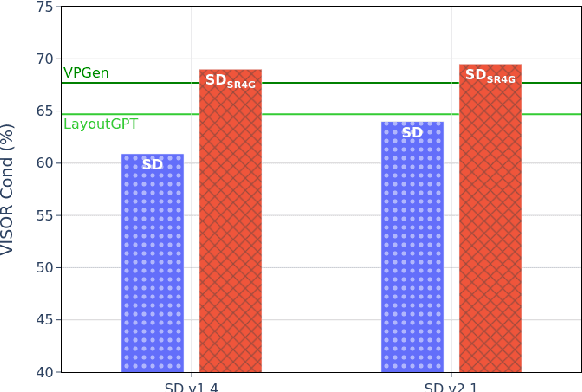


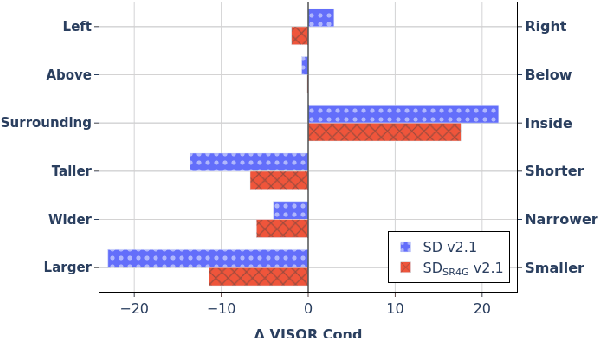
Abstract:Existing work has observed that current text-to-image systems do not accurately reflect explicit spatial relations between objects such as 'left of' or 'below'. We hypothesize that this is because explicit spatial relations rarely appear in the image captions used to train these models. We propose an automatic method that, given existing images, generates synthetic captions that contain 14 explicit spatial relations. We introduce the Spatial Relation for Generation (SR4G) dataset, which contains 9.9 millions image-caption pairs for training, and more than 60 thousand captions for evaluation. In order to test generalization we also provide an 'unseen' split, where the set of objects in the train and test captions are disjoint. SR4G is the first dataset that can be used to spatially fine-tune text-to-image systems. We show that fine-tuning two different Stable Diffusion models (denoted as SD$_{SR4G}$) yields up to 9 points improvements in the VISOR metric. The improvement holds in the 'unseen' split, showing that SD$_{SR4G}$ is able to generalize to unseen objects. SD$_{SR4G}$ improves the state-of-the-art with fewer parameters, and avoids complex architectures. Our analysis shows that improvement is consistent for all relations. The dataset and the code will be publicly available.
Unsupervised Domain Adaption for Neural Information Retrieval
Oct 13, 2023Abstract:Neural information retrieval requires costly annotated data for each target domain to be competitive. Synthetic annotation by query generation using Large Language Models or rule-based string manipulation has been proposed as an alternative, but their relative merits have not been analysed. In this paper, we compare both methods head-to-head using the same neural IR architecture. We focus on the BEIR benchmark, which includes test datasets from several domains with no training data, and explore two scenarios: zero-shot, where the supervised system is trained in a large out-of-domain dataset (MS-MARCO); and unsupervised domain adaptation, where, in addition to MS-MARCO, the system is fine-tuned in synthetic data from the target domain. Our results indicate that Large Language Models outperform rule-based methods in all scenarios by a large margin, and, more importantly, that unsupervised domain adaptation is effective compared to applying a supervised IR system in a zero-shot fashion. In addition we explore several sizes of open Large Language Models to generate synthetic data and find that a medium-sized model suffices. Code and models are publicly available for reproducibility.
Do Multilingual Language Models Think Better in English?
Aug 02, 2023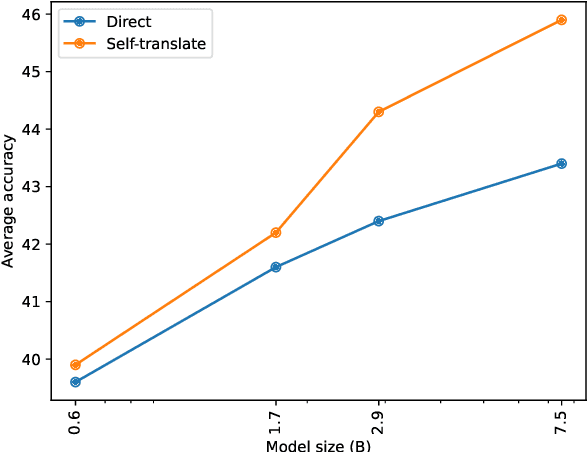

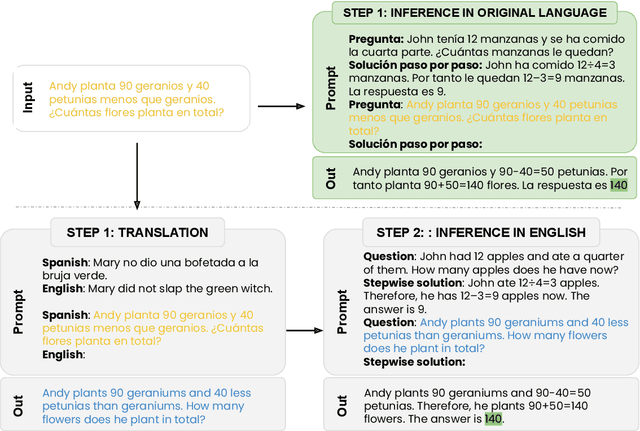

Abstract:Translate-test is a popular technique to improve the performance of multilingual language models. This approach works by translating the input into English using an external machine translation system, and running inference over the translated input. However, these improvements can be attributed to the use of a separate translation system, which is typically trained on large amounts of parallel data not seen by the language model. In this work, we introduce a new approach called self-translate, which overcomes the need of an external translation system by leveraging the few-shot translation capabilities of multilingual language models. Experiments over 5 tasks show that self-translate consistently outperforms direct inference, demonstrating that language models are unable to leverage their full multilingual potential when prompted in non-English languages. Our code is available at https://github.com/juletx/self-translate.
 Add to Chrome
Add to Chrome Add to Firefox
Add to Firefox Add to Edge
Add to Edge